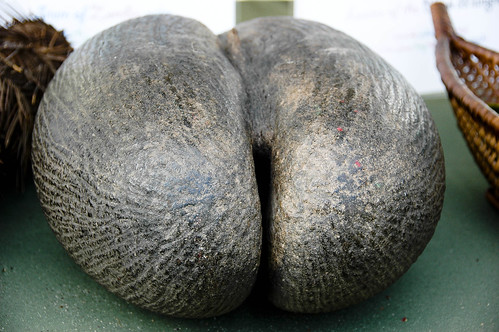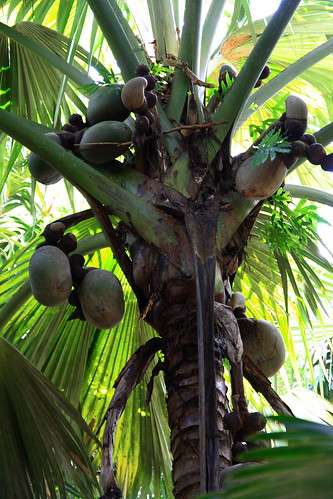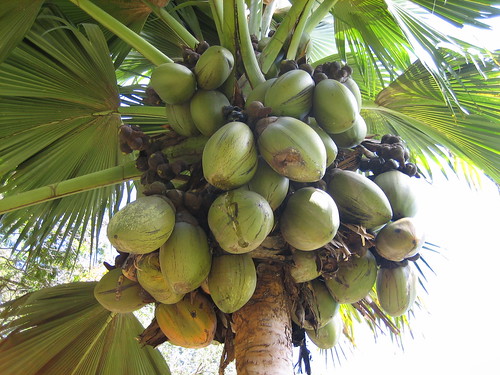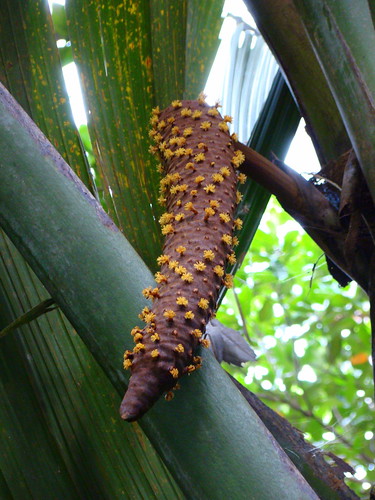Double Coconut
Lodoicea maldivica
Palm family The largest seed in the plant kingdom looks like two coconuts fused together, giving rise to this fan palm’s common name. The plant is tender and very slow-growing, especially when young (for instance, the nut takes a year to germinate and another year to form its first leaf); hence, it is rarely cultivated. Eventually, it can attain heights of 100 feet and leaf blades to 20 feet in length and 12 feet in diameter. The fan palm is native to only a few islands in the Seychelles, located off the east coast of Africa in the Indian Ocean. For centuries its nuts were mistakenly thought to come from the Maldive Islands, an error preserved in its Latin name.
This is what we called COCO DE MER, and it grows in Seychelles

http://en.wikipedia.org/wiki/Coco_de_MerThe Coco de Mer (Lodoicea maldivica), the sole member of the genus Lodoicea, is a palm endemic to the islands of Praslin and Curieuse in the Seychelles. It formerly also occurred on St Pierre, Chauve-Souris and Ile Ronde (Praslin) in the Seychelles group but has become extinct on these islands.
It grows to 25-34 m tall. The leaves are fan-shaped, 7-10 m long and 4.5 m wide with a 4 m petiole. It is dioecious, with separate male and female plants. The male flowers are catkin-like, up to 1 m long. The mature fruit is 40-50 cm in diameter and weighs 15–30 kg, and contains the largest seed in the plant kingdom. The fruit, which requires 6–7 years to mature and a further two years to germinate, is sometimes also referred to as the Sea Coconut, double coconut, coco fesse, or Seychelles Nut.
Formerly the Coco de Mer was known as Maldive Coconut. Its scientific name, Lodoicea maldivica, originated before the 18th century when the Seychelles were uninhabited. In centuries past the coconuts that fell from the trees and ended up in the sea would be carried away westwards by the prevailing sea currents. The nuts can only float after the germination process, when they are hollow. In this way many drifted to the Maldives where they were gathered from the beaches and valued as an important trade and medicinal item.[1]
Legend has it that sailors who first saw the nut floating in the sea imagined that it resembled a woman‘s disembodied buttocks. This association is reflected in one of the plant’s archaic botanical names, Lodoicea callipyge Comm. ex J. St.-Hil., in which callipyge is from Greek words meaning ‘beautiful rump’. Other botanical names used in the past include Lodoicea sechellarum Labill. and Lodoicea sonneratii (Giseke) Baill.
Until the true source of nut was discovered in 1768, it was believed by many to grow on a mythical tree at the bottom of the sea; European nobles in the sixteenth century would often have the shells of these nuts cleaned and decorated with valuable jewels as collectibles for their private galleries. The Coco de Mer is now a rare protected species.
The name of the genus, Lodoicea, is derived from Lodoicus, the Latinised form of Louis, in honour of King Louis XV of France.
The species is grown as an ornamental tree in many areas in the tropics, and subsidiary populations have been established on Mahé and Silhouette Islands in the Seychelles to help conserve the species.
The fruit is used in Ayurvedic medicine and also in traditional Chinese medicine.


Male flower of the Coco de Mer. The small yellow blossom smell like popcorn. Seen in Vallee de Mai National Park on Praslin.




An interesting article on Bluepeace website: http://bluepeacemaldives.org/news2004/coconutmaldivica.htm
Wow! Looks like coconut.. Any idea how it tastes like?